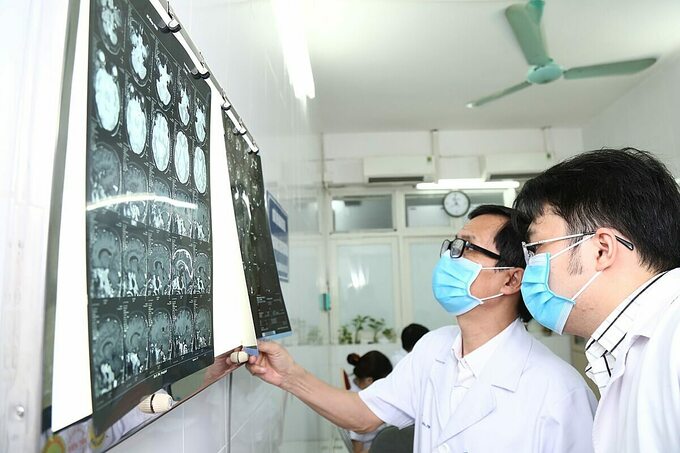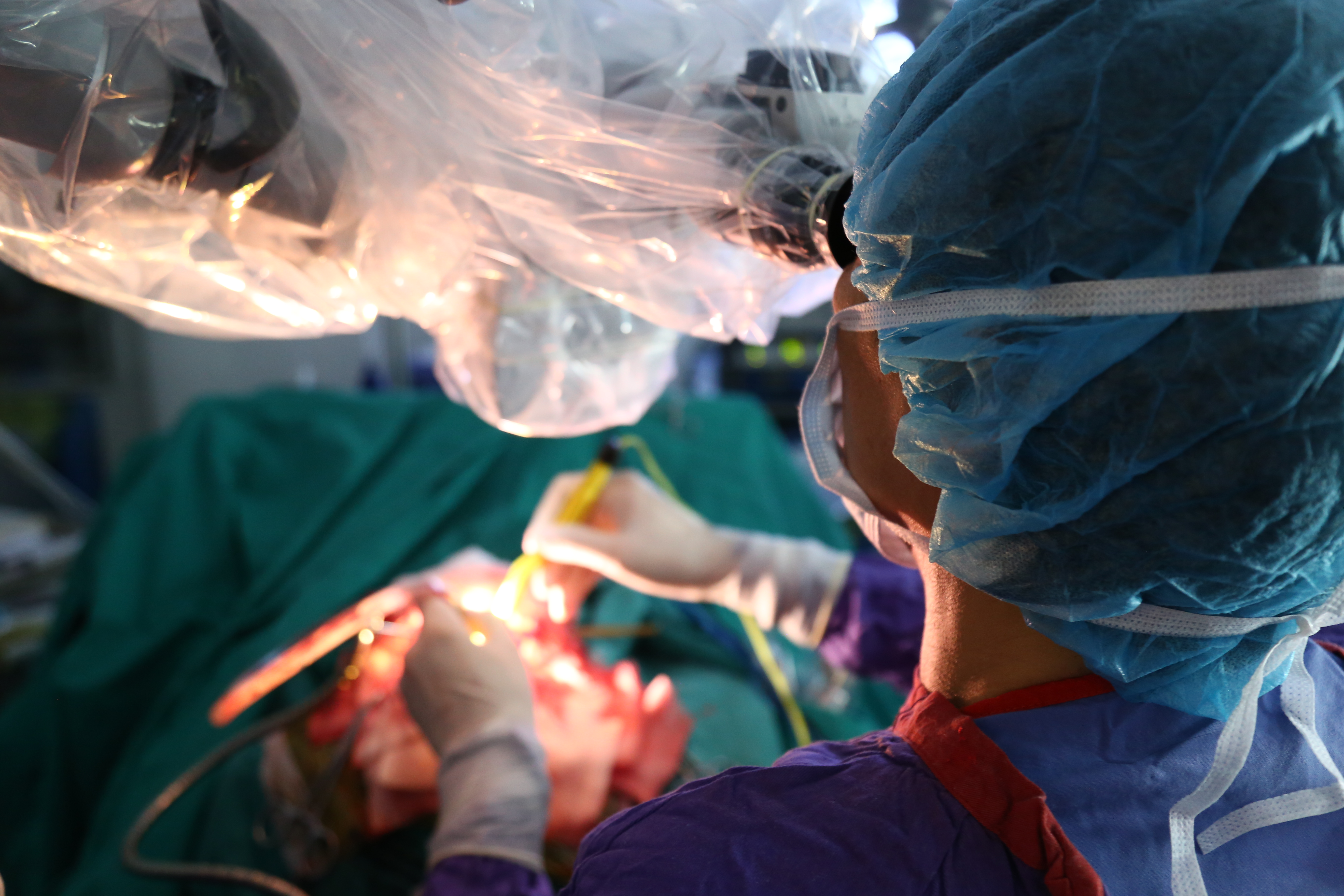Being examined for blurred vision, suddenly the female patient was diagnosed with a giant brain aneurysm
04/11/2020 13:58
Suckhoedoisong.vn – There are many types of cerebrovascular malformation, but the most frequent are cerebral aneurysm and hemangioma or Cerebral Cavernoma (CCM). Up to now, the exact cause of cerebrovascular malformation was not identified.
“Panic” with giant cerebral aneurysm
Seeking doctor for blurred vision, patient V.H.H., female, 64 years old, was diagnosed with giant cerebral aneurysm about 6 cm in size while normally only 2 – 10 mm.
According to specialists, this is a quite extraordinary cerebrovascular malformation, a giant cerebral aneurysm. Before that, she did not have any abnormality signs except gradually blurred vision. At first, she thought that it might be due to the old age but then her left eye was blurred almost completely. Right vision was more than 50%.
At this time, her family took her for the examination. Diagnostic imaging results showed an extremely huge mass suspecting a brain tumor so she was transferred to Viet Duc University Hospital.
Ass. Prof. DONG Van He, Vice director of Viet Duc University Hospital, Director of Neurosurgery Center shared that that huge mass in the patient’s brain was actually a giant aneurysm over 6 cm in size, while normally only 2 – 10 mm. One complicated operation was predicted.
“Most likely, we have to perform the operation in multiple stages. The first stage is to perform angioplasty in order to vascularize the brain with other vessels, then to handle the aneurysm because it involved a lot of structures surrounding ” Ass. Prof. DONG Van He informed.

Ass. Prof. DONG Van He and his colleagues were seeing images of a cerebral aneurysm patient
Most of cases was detected coincidentally on the imaging diagnosis
At the Neurosurgery Center, almost every week, we meet patients with cerebral aneurysm or malformation diagnosed by chance, however, giant aneurysm in case of Mrs. H. is very rare.
According to Ass. Prof. DONG Van He, there are many types of cerebrovascular malformation but the most frequent ones are cerebral aneurysm and CCM. Those conditions were congenital but not detected physically until taking diagnostic imaging.
Up to now, science has not found the exact cause of cerebrovascular malformation, however, it might relate to a history of infection or trauma. In some cases, it was congenital, not genetic but happened during pregnancy the baby already has.
Most cerebrovascular malformation cases do not show any special clinical symptoms. If so, patient may experience headache. However, this is not specific sign. There are a lot of potential causes of headache such as bad weather or stress.
In addition, some cases may present epilepsy, some signs of motor area causing numbness or other symptoms such as blepharoptosis due to mass effect of huge vascular malformation nearby important nerves.
It is estimated that 3 – 5% of population has a cerebral aneurysm meaning 3 – 5 out of every 100 people. However, in most cases, it is not ruptured complication, with no symptoms or signs of illness. Only about 0.25% of those will suffer from ruptured aneurysm.
How to “get along” with this disease?
Ass. Prof. DONG Van He-Vice director of Viet Duc University Hospital added that because cerebral aneurysm is hardly ruptured so most patients live together with this, the treatment is only required for those at high risk.
“At Viet Duc University Hospital, we noted that the most common reasons for a cerebral CT Scan or MRI were headache and brain trauma. With those images, the non-ruptured aneurysm could be detected” Ass. Prof. DONG Van He said.
Most patients with non-ruptured aneurysm were diagnosed by cerebrovascular CT scan or MRI. A few cases were diagnosed with angiography. Because angiography is an invasive exploration so it was indicated when CT scan or MRI diagnosis was unsure or for pre-interventional assessment.
“Factors influencing the rate of aneurysm rupture include size, location, morphology of the aneurysm, medical history, family history and patient’s age. The bigger the aneurysm, the higher risk of rupture. If the aneurysm is over 5 mm, it is at the high risk so doctors should recommend an intervention. Some authors thought that aneurysm over 3mm in size should be handled” Ass. Prof. DONG Van He informed.
Aneurysm at anterior communicating artery, posterior communicating artery, anterior, middle and posterior cerebral artery should be intervened.

Viet Duc University Hospital’s specialists performed a cerebral aneurysm operation
If patient has ever had a cerebral hemorrhage (subarachnoid hemorrhage), an intervention is needed. In case of patient’s family member had subarachnoid hemorrhage, an intervention is also recommended. Patient’s age is a considering factor for surgical indication. If patient is young, an intervention is recommended. If patient is aging (over 70 year-old), conservative treatment should be considered.
Some cases of non-ruptured cerebral aneurysm are treated by surgery (aneurysm neck clamping) or embolization. These are 2 routine treatments in many medical facilities. The success rates of both are similar while embolization is with higher cost because most of the materials are imported.
Ass. Prof. He recommended that if there is no medical treatment, patients must change their lifestyle, stop smoking and drinking alcohol, control arterial hypertension, hyperlipidemia, obesity, do not use contraceptive pill … because these factors will increase the risk of aneurysm rupture.
Patients also need regular follow-up in every 6 months in several first years then every 12 months after. If the aneurysm enlarged, an intervention will be recommended. If after 10 – 20 years of follow-up, the aneurysm does not grow up, the patient might be secured to get along with.
In order to help people to better understand how to prevent, to care, to follow up and to treat cerebrovascular troubles, on the October 31st, 2020, Viet Duc University Hospital organized a program of free examination and consultation on cerebrovascular diseases.
Joining the program, in addition to free expert consultation, 5 first patients nd already booked via Call Center 19001902 will receive a free CT Scan.
Time: 7h30 on the October 31st, 2020
Address: Clinic No 9 and 11, 2nd floor, C4 building, On-demand Clinic, Viet Duc University Hospital.











